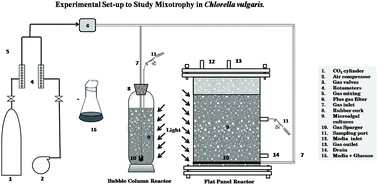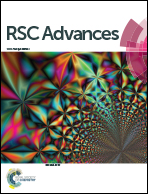Rationally leveraging mixotrophic growth of microalgae in different photobioreactor configurations for reducing the carbon footprint of an algal biorefinery: a techno-economic perspective
Abstract
Mixotrophy, the ability of an organism to simultaneously assimilate carbon dioxide (CO2) and organic carbon, is of prime importance to algal biorefineries because it boosts algal biomass productivities, associated-CO2 capture rates and intercellular lipid content; along with wastewater remediation. In the present study, the effect of light, CO2 and glucose, in various permutations, on the growth of Chlorella vulgaris, cultivated in flat panel and bubble column photobioreactors, was investigated. The average specific growth rate of Chlorella vulgaris in light-sufficient conditions when supplied with (−glucose, −CO2); (−glucose, +CO2); (+glucose, −CO2) and (+glucose, +CO2) were 0.048 h−1, 0.075 h−1, 0.080 h−1 and 0.084 h−1, respectively in flat panel reactors. The corresponding specific growth rates in bubble column reactors were 0.042 h−1, 0.070 h−1, 0.082 h−1 and 0.083 h−1. Chlorella vulgaris was found to require light for assimilation of glucose because it did not grow in the dark under glucose-sufficient conditions. Furthermore, carbon balance revealed that the mixotrophic cultivation of Chlorella vulgaris had a positive carbon footprint (pseudo-mixotroph). Literature review revealed that the carbon footprint of mixotrophic algal cultivation may be negative (true-mixotroph) or positive depending upon the predominant mode of nutrition and the cultivation conditions. The novelty of the present study lies in the formulation of a strategy to identify true-and-pseudo-mixotrophs and their subsequent utilization for design of low-cost, minimal-resource and high-throughput cultivation strategies for biomass generation and CO2 sequestration in algal biorefineries.


 Please wait while we load your content...
Please wait while we load your content...